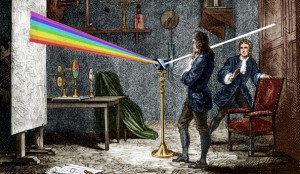Back in time when Newton was around (1642-1726 ), people thought that color was a mixture of light and darkness, and that prisms colored light. Isaac Newton didn’t believe that so he decided to test it out for himself and around 1665 he passed white light through a prism. Here he identified seven colours: red, orange, yellow, green, blue, indigo, and violet. These colours he referred to the colours of the rainbow and that they were analogous to the notes of the musical scale.
In Newton’s color wheel, in which the colors are arranged clockwise in the order they appear in the rainbow, each “spoke” of the wheel is assigned a letter. These letters correspond to the notes of the musical scale.
What he did was that he projected white light through a prism onto a wall and had a friend mark the boundaries between the colours, which he then named. In his diagrams, which show how colours respond to notes, Newton introduced two new colours, orange and indigo. These to colours would correspond to half the steps in the octatonic scale.
In physics terminology, an octave is the frequency range from x to 2x, and that premise holds true for musical octaves. If light behaved like music, then photon frequencies of the spectrum would also range from x to 2x, and their wavelengths, inversely proportional to their frequencies, would too. Instead, the wavelengths of visible light range from 400 to 700 nanometers, which, if translated to sound waves, would be approximately equivalent to a major sixth.
Therefore Isaac Newtons colour theory was actually incorrect as the frequency range in an octave is different than photon frequencies of light spectrum. Although his theory falls apart his experiments with prisms showed us that white light is a mix of different coloured lights.
If all this sounds very confusing then don’t be alarmed. I recommend watching this video about the octatonic scale which Newton related his colour theory to. It creates a picture of the different layers of tones that Newton was trying to relate to the prism reflection with white light.

